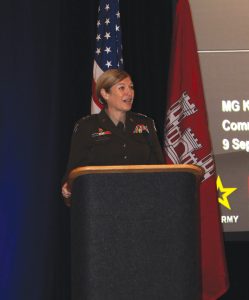Smart Rivers 2025 Convenes in Memphis
More than 300 people from six continents gathered September 8-12 in Memphis, Tenn., for Smart Rivers 2025, a conference bringing together the international community to share the latest innovations and best practices for waterborne transportation on inland waterway systems.
The conference was sponsored by PIANC USA on behalf of PIANC, the French acronym for the World Association for Waterborne Transport Infrastructure. Founded in 1885 in Brussels, Belgium, the organization has been the sponsor of Smart Rivers for the past 10 of its 20 years. It was the organization’s fourth conference in the United States.
In welcoming conference-goers to Memphis, Col. John Morrow of the Memphis Engineer District recalled the words of Mark Twain, who wrote in his memoir “Life on the Mississippi” that the Mississippi River “had a new story to tell every day.”
“This week, as we gather, we are writing a new chapter through collaboration, innovation and stewardship,” Morrow said.
Major Gen. Jason Kelly, deputy commanding general for civil and emergency operations for the Corps of Engineers and president of PIANC USA, led the speakers for the first full day of presentations on September 9.
He began by stressing the critical importance of the inland marine transportation system in the United States.
“This system isn’t simply a network of rivers and canals,” he said. “It’s a cornerstone of national logistics and global competitiveness. It’s absolutely essential for supply chain resilience, particularly as our roads and rail systems increasingly reach capacity.”
The nation’s inland waterway system transports 400 million tons of domestic goods annually, he said.
“These aren’t luxury items,” Kelly said. “They’re the bulk commodities that fuel our economy—grain to feed the world, coal to power our industries, petroleum to keep us moving and aggregates to build. And this system isn’t just about domestic consumption. It’s a critical link to export markets driving American economic growth.”
However, he added, “We cannot take this system for granted. We all acknowledge the reality. Many of the locks and dams that comprise the network are beyond their design life. They’ve served us well, but they now require increased maintenance and ultimately rehabilitation to continue to function reliably. This is not a future problem. This is a present challenge. We’re not talking about tomorrow. It’s about today.”
Kelly noted that the Corps, in collaboration with PIANC and other stakeholders, is focused on monitoring key performance indicators to proactively address these challenges. That includes tracking when mechanically driven failures at locks result in delays of more than 24 hours and, more critically, those that result in delays of more than one week, he said.
“The data reveals some concerning trends,” he said.
While the country has generally maintained a stable trend of 10 or fewer closures of more than one day in recent years, the number of closures lasting one week or more has risen from two or three in previous years to five in the past year.
“This isn’t simply a statistical anomaly,” Kelly said. “It represents the real-world impacts on business and communities that rely on our waterways.”
While the system has maintained 95 percent lock availability between August 2024 and the present, which Kelly said is a testament to those working on and alongside the waterways, “Those of you who know me know 95 percent is not good enough,” he said. “I want 100 percent reliability. To achieve that, we have to embrace innovation. We have to leverage technology. We’re committed to doing all that we can to provide an available and reliable system, and we have to do this while facing the challenges within the system head-on.”
Kelly mentioned lock control modernization projects to streamline operations and improve efficiency, digital twins to allow simulated performance and identify potential vulnerabilities before they can become critical failures, fiber-reinforced polymers to extend the lifespan of infrastructure components and sophisticated data analytical tools to provide valuable insights into infrastructure performance, permitting predictive maintenance and proactive intervention.
“These aren’t futuristic concepts,” he said. “They are being implemented today, and PIANC is proud to be a facilitator of this progress, providing the technical expertise and international best practices to support these initiatives.”
Kelly was followed at the speaker’s podium by Francisco Esteban Lefler, president of PIANC, who described the organization as “a worldwide network of professionals providing expert advice on cost-effective and sustainable waterborne transportation” as well as a “leading partner for governments and private sector in design, development and maintenance of ports, waterways and coastal areas.”
PIANC focuses on delivering high-quality technical reports within international commissions and working groups, he said. It has more than 550 corporate members, about 1,650 individual members and 46 “qualifying members,” of which 33 have a national section, a governmental or non-governmental organization representing a country.
Maj. Gen. Kimberly Peeples, commander of the Corps’ Mississippi Valley Division, noted that while participants at the conference came from all areas of the world, “We all speak a common language, and that’s the language of river.”

Peeples then introduced the opening session’s keynote speaker, Dr. Norma Jean Mattei, professor emeritus of the University of New Orleans and a former member of the Mississippi Valley Commission, on which Peeples serves as president.
Mattei gave a history of the control of the Mississippi River by various nations, beginning with its name, deriving from the Algonquian “Misi-ziibi,” meaning “great river.” She then spoke about the approaching 100th anniversary of the Mississippi River and Tributaries Project (MR&T), authorized by Congress after the devastating 1927 flood, still considered the most destructive natural disaster in U.S. history.
Mattei overviewed flood control and channel stability efforts as well as construction of infrastructure.
“We built most of this stuff in the ’30s, just like MR&T,” she said, adding, “We’ve got to put more into our system to keep it reliable.”
Challenges include the need for standardization in parts on the system and the need for system resiliency through modernized and enlarged lock chambers along with guaranteed sources of funding for inland ports and the challenges of recent more extreme weather patterns.
Throughout, the conference was interspersed with plenary sessions and technical breakout sessions built around the topic of “Celebrating the World’s Navigable Rivers.”
They covered topics such as navigation locks and structures, contracting and financing of river infrastructure, smart shipping and artificial intelligence, waterway planning and design, river hydraulics and hydrology, resilience, international waterway management, waterway innovation, communities and waterfront development and navigation management.
Those attending the conference also had the option to participate in short courses on design of navigation locks, composites for hydraulic structures and sustainable practices for dredge material placement and bank protection along with tours of the Port of Memphis, the Memphis waterfront, the mv. Mississippi and, for fun, Graceland, the Memphis home of the king of rock ‘n’ roll, Elvis Presley.
More information about conference sessions will be provided in future issues of The Waterways Journal.



